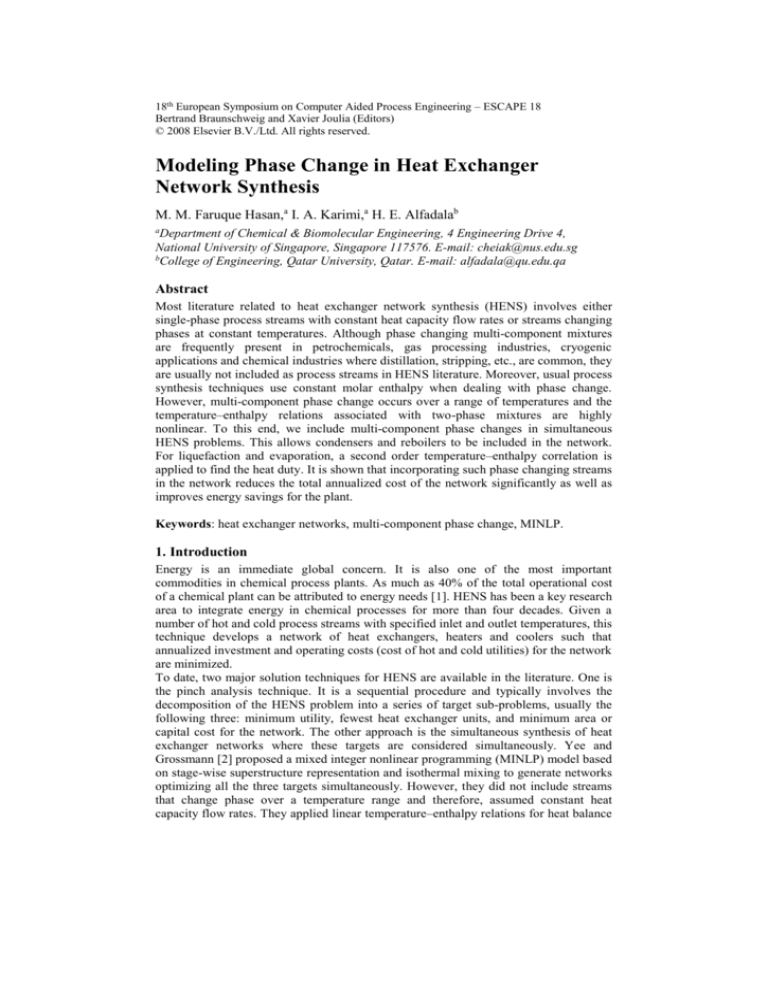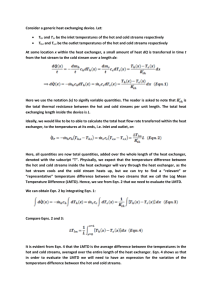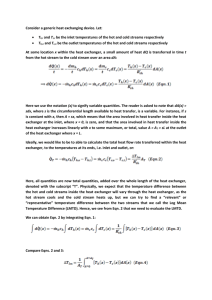
18th European Symposium on Computer Aided Process Engineering – ESCAPE 18
Bertrand Braunschweig and Xavier Joulia (Editors)
© 2008 Elsevier B.V./Ltd. All rights reserved.
Modeling Phase Change in Heat Exchanger
Network Synthesis
M. M. Faruque Hasan,a I. A. Karimi,a H. E. Alfadalab
a
Department of Chemical & Biomolecular Engineering, 4 Engineering Drive 4,
National University of Singapore, Singapore 117576. E-mail: cheiak@nus.edu.sg
b
College of Engineering, Qatar University, Qatar. E-mail: alfadala@qu.edu.qa
Abstract
Most literature related to heat exchanger network synthesis (HENS) involves either
single-phase process streams with constant heat capacity flow rates or streams changing
phases at constant temperatures. Although phase changing multi-component mixtures
are frequently present in petrochemicals, gas processing industries, cryogenic
applications and chemical industries where distillation, stripping, etc., are common, they
are usually not included as process streams in HENS literature. Moreover, usual process
synthesis techniques use constant molar enthalpy when dealing with phase change.
However, multi-component phase change occurs over a range of temperatures and the
temperature–enthalpy relations associated with two-phase mixtures are highly
nonlinear. To this end, we include multi-component phase changes in simultaneous
HENS problems. This allows condensers and reboilers to be included in the network.
For liquefaction and evaporation, a second order temperature–enthalpy correlation is
applied to find the heat duty. It is shown that incorporating such phase changing streams
in the network reduces the total annualized cost of the network significantly as well as
improves energy savings for the plant.
Keywords: heat exchanger networks, multi-component phase change, MINLP.
1. Introduction
Energy is an immediate global concern. It is also one of the most important
commodities in chemical process plants. As much as 40% of the total operational cost
of a chemical plant can be attributed to energy needs [1]. HENS has been a key research
area to integrate energy in chemical processes for more than four decades. Given a
number of hot and cold process streams with specified inlet and outlet temperatures, this
technique develops a network of heat exchangers, heaters and coolers such that
annualized investment and operating costs (cost of hot and cold utilities) for the network
are minimized.
To date, two major solution techniques for HENS are available in the literature. One is
the pinch analysis technique. It is a sequential procedure and typically involves the
decomposition of the HENS problem into a series of target sub-problems, usually the
following three: minimum utility, fewest heat exchanger units, and minimum area or
capital cost for the network. The other approach is the simultaneous synthesis of heat
exchanger networks where these targets are considered simultaneously. Yee and
Grossmann [2] proposed a mixed integer nonlinear programming (MINLP) model based
on stage-wise superstructure representation and isothermal mixing to generate networks
optimizing all the three targets simultaneously. However, they did not include streams
that change phase over a temperature range and therefore, assumed constant heat
capacity flow rates. They applied linear temperature–enthalpy relations for heat balance
2
M. M. F. Hasan et al.
constraints (overall heat balance, heat balance at each stage and hot and cold utility
loads). Ciric and Floudas [3] also proposed fully simultaneous HENS formulation.
Although HENS plays a significant role in controlling the costs of energy for a process,
the existing HENS literature has been limited to only single-phase process streams or
streams changing phase at single temperature. This is in spite of the fact that multicomponent phase changes abound in most chemical processes in petrochemical, gas
processing, and cryogenic applications. This type of phase change is usually present in
condensers, reboilers or evaporators in a chemical plant. To our knowledge, the current
HEN synthesis literature does not accommodate heat exchangers that involve multicomponent phase change such as those in liquefied natural gas and air separation plants.
Since they are not part of the overall network, usually no process streams are used to
exchange heat with them; only utilities or energy-intensive refrigeration are considered.
This incurs higher energy and operating cost for the plant.
In this paper, we extend the simultaneous MINLP formulation for HENS to multicomponent phase change for mixture streams. Thus we incorporate condensers and
reboilers as part of the plant heat exchanger network. We present a modification in heat
balance constraints to calculate the enthalpy changes more accurately when multiple
heat exchangers are used for the same phase changing mixture. With this modification,
we show that although the presence of multiple condensers or evaporators for a phase
changing mixture might increase the investment cost, it can decrease the total
annualized cost for the heat exchanger network and improve the overall energy savings
of the plant.
2. Problem Statement
Since some of the process streams undergo multi-component phase change, we define
the HENS problem as follows:
Given
a set of hot process streams (i I) among which a set PI (PI I) undergoes phase
change,
a set of cold process streams ( j J) among which a set PJ (PJ J) undergoes
phase change,
all the inlet and outlet temperatures and temperature ranges for phase change,
the utilities available, utility and heat exchanger cost data,
develop a heat exchanger network with minimum annualized cost.
3. Methodology
In HENS problems, phase change that takes place at single temperature can be treated
by assuming a unit change in temperature during phase transition and then calculating a
fictitious heat capacity flow rate value that gives the same duty as the phase change [4].
However, this technique cannot be used for mixture streams. Phase change for a multicomponent mixture usually occurs over a long range of temperatures and temperature–
enthalpy relation associated with a two-phase mixture is highly nonlinear. Neither heat
capacity flow rates nor molar enthalpies of such process streams are constants with
temperature. Figure 1 shows a temperature–enthalpy curve with three distinct regions
partitioned by bubble and dew points. It is evident from Figure 1 that the temperature–
enthalpy relation is nonlinear for the two-phase region. Moreover, Castier and Queiroz
[5] showed that targeting procedures based on a single linearization between the bubble
and dew points and on the constant heat capacity assumption may end up with wrongly
located pinch points. Although simultaneous HENS technique does not require pinch
Modeling phase change in heat exchanger network synthesis 3
points, linear heat balance equations used in the MINLP model would always be less
accurate and prone to suboptimal solutions when dealing with multi-component phase
change.
In this work, we extend the Synheat model of Yee and Grossmann [2] to include multicomponent phase change. One option to avoid nonlinearities for this case is to restrict a
stream to exchange the entire heat required for phase change in a single heat exchanger.
Therefore, the amount of heat exchanged would be only the difference between the
enthalpies at the bubble and dew point temperatures. However, it is shown later in
example 1 that restricting multi-component phase change to occur in a single heat
exchanger may result in suboptimal network with higher annualized cost. We now
describe the proposed modifications required to incorporate multi-component phase
change in the simultaneous MINLP model.
20
Gas
Temperature [0C]
-25
Tdp
Two phase
-70
T
bp
Liquid
-115
-160
-205
0
4000
8000
12000
16000
Enthalpy[kJ/kmol]
Figure 1. Temperature–enthalpy relation showing nonlinear two-phase region
3.1. Estimating heat duty for the two-phase region
In order to capture the nonlinearities in temperature–enthalpy relations for phase
changing streams, we apply second order heat balance equations of the following type:
H A BT CT 2
(1)
where, ∆H is the change in enthalpy due to a temperature change of ∆T and parameters
A, B, and C are estimated for a set of temperature–enthalpy data collected over the
entire two-phase region. Therefore, we now use the following constraints in the Synheat
model instead of linear heat balance constraints for phase changing streams:
Overall heat balance:
q
ijk
j
(2)
qhu j Aj B j TOUT j TIN j C j TOUT j TIN j , j PJ
(3)
2
k
q
ijk
i
qcui Ai Bi TIN i TOUTi Ci TIN i TOUTi , i PI
k
2
4
M. M. F. Hasan et al.
Heat balance at each stage:
q
ijk
Ai Bi tik tik 1 Ci tik tik 1 , i PI
(4)
Aj B j t jk t jk 1 C j t jk t jk 1 , j PJ
(5)
2
j
q
ijk
2
i
Hot and cold utilities load:
qcui Ai Bi ti , NOK 1 TOUTi Ci ti , NOK 1 TOUTi , i PI
(6)
qhu j Aj B j TOUT j t j ,1 Ci TOUT j t j ,1 , j PJ
(7)
2
2
where, tik and tjk are the temperatures of hot stream i and cold stream j at stage k and qijk,
qcui, qhuj are the heat duties in the model for the heat exchangers, coolers and heaters
respectively.
3.2. Temperature differences
Usually logarithmic mean temperature difference (LMTD) is used in calculating the
heat transfer area for heat exchangers in the network. However, LMTD calculation
assumes isothermal phase transition. Moreover, the fraction of the total heat load for a
fractional change in temperature during multi-component phase change is not always
uniform. Therfore, the use of LMTD to calculate heat transfer area for such case can be
error prone. However, the errors resulting from the use of LMTD are usually on the safe
side and satisfactory for any system without serious fronts or tails in the condensing
curves [6]. For the cases of a 1-2 condenser and where condensing curves have fronts
or tails, the use of LMTD or FT×LMTD can result in inaccurate heat transfer area which
is prohibitive for optimal HENS. In such cases, weighted temperature difference instead
of LMTD would be more reasonable to use.
4. Examples
Two examples are presented to illustrate the synthesis of heat exchanger networks
involving multi-component phase change.
4.1. Example 1
The first example involves two hot and two cold streams (Table 1). Between the two hot
streams, H1 is a condensing stream with inlet temperature at its dew point (568 K) and
outlet temperature at its bubble point (513 K). This example is presented to illustrate
that incorporating phase changing streams can reduce the annualized cost significantly.
We solve it for two cases. In the first case, we restrict H1 to be condensed in a single
condenser, as usually done in chemical plants. However, in the second case, we do not
impose this restriction. This is possible when we use more accurate nonlinear heat
balances (Eq. 2−7) in the formulation. This allows calculation of actual enthalpy
changes in each of the condensers or reboilers for multi-component phase change. The
maximum error in predicting enthalpy by using the given A, B and C values is ±1.1%
which is quite small. The computing platform used for the example is Dell Optiplex GX
280 with Pentium IV HT 3.20 GHz 2 GB RAM and the model is solved by using
GAMS/BARON 7.5 with CPLEX 10 (LP) and MINOS 5.5 (NLP).
When the model is solved for the first case, H1 only uses cold utility (CU) to change its
phase in a single condenser whereas H2 exchanges heat with both C1 and C2 and C1
Modeling phase change in heat exchanger network synthesis 5
requires a heater with a total annual HEN cost of $2059848. Since H1 changes phase in
a single condenser and neither C1 nor C2 alone is sufficient to take out the entire heat
for phase change, cold utility is used in the condenser. This increases the annualized
cost of the network. However, for the second case, H1 requires two condensers, one
using C1 and the other using CU as the cooling media. H2 exchanges heat with C2 and
CU. The resulting HEN also has a heater for C1. Although the number of heat
exchangers is more than the first case, the annualized HEN cost is now $1689913 which
is about 18% less than the first case. Utility costs are also reduced by 19%. Therefore,
incorporating phase change in the model formulation and related heat exchangers in the
network reduces the annualized cost as well as the net energy consumption of the
network significantly.
Table 1. Stream data for example 1
Stream
Tin (K)
Tout (K)
h (kW/m2K)
H1
H2
C1
C2
HU
CU
568
523
393
313
598
298
513
363
573
498
598
313
2.50
0.15
0.10
0.20
2.00
0.50
F (kW/K)
40
35
20
H1 (A = 0, B = 21.8, C = 50.5). Heat Exchanger and coolers ($ per year): 15000+30(area)0.8 (a =
area in m2); Heaters ($ per year): 15000+60a0.8; Condensers ($ per year): 15000+90a0.8; utility
costs ($kW per year): hot 110; cold 10.
Table 2. Stream data for example 2
Stream
Tin(K)
Tout(K)
h (kW/m2K)
F (kW/K)
H1
H2
H3
H4
H5
C1
C2
C3
HU
CU
273
310
320
293
273
292
238
109
293
400
240
273
298
244
240
293
239
115
313
400
2.5
2.5
0.1
0.1
0.1
0.1
0.1
0.1
2.0
0.5
1150
1250
48
29900
151810
1240
H1 (A = 0, B = 67.95, C = 7.043); H2 (A = 0, B = 32.43, C = 5.25).Heat Exchanger and coolers ($
per year): 15000+30a0.8 (a = area in m2); Heaters ($ per year): 15000+60a0.8; Condensers and
evaporators ($ per year): 15000+90a0.8; utility costs ($kW per year): hot 11; cold 1.
4.2. Example 2
This example is solved for a liquefaction plant (Table 2) where two gas streams (H1 and
H2) are completely liquefied via refrigeration. Since H1 and H2 undergo multicomponent phase change, we use the modified heat balances for them. C1 and C2
change their phases at constant temperatures. Therefore, we apply the technique of
changing their phases in between a temperature difference of 1 K and then calculating
the fictitious heat capacity flow rates (F) for C1 and C2. H3, H4, H5 and C3 do not
change their phases.
6
M. M. F. Hasan et al.
Example 2 is solved by using GAMS/DICOPT with CPLEX 10 (LP) and CONOPT 3
(NLP). Figure 2 shows the resulting HEN with corresponding heat duties. The
annualized cost of HEN is $1446015. C2 exchanges heat with all the hot streams. We
need to split H1 into two streams and use one condenser for each of them to exchange
heat with C2 and C3. Only one condenser is required for H2. Note that no utilities are
needed for both of the condensing streams. Therefore, this network saves utility cost to
a large extent.
7440
2472.18
H1
8387.16
H2
25300
H3
61250
H4
1584
H5
H1
C1
H2
C2
C3
Figure 2. Resulting HEN for example 2
5. Conclusions
A HENS model that incorporates phase change of multi-component mixtures is
presented. The model assumes a second order temperature–enthalpy relation within a
temperature range between dew and bubble points. Since this modified HENS model
accommodates not only usual heat exchangers but also heat exchangers like condensers
and reboilers where phase change occurs for multi-component mixtures, better heat
integration and energy savings are possible by using this model. Furthermore, we
showed that although the presence of multiple condensers or evaporators might increase
the investment cost, it decreases the total annualized cost for the heat exchanger
network by reducing overall utility consumption.
References
1. M. Zargarzadeh, I. A. Karimi, H. E. Alfadala, ESCAPE17, Bucharest, Romania, May
27−30, 2007.
2. T. F. Yee and I. E. Grossmann, Comput. Chem. Eng., 14(1990)1165.
3. A. R. Ciric and C. A. Floudas, Comput. Chem. Eng., 15(1991)385.
4. J. M. Douglas, Conceptual design of chemical processes, New York: McGraw-Hill, 1988.
5. M. Castier and E. M. Queiroz¸ Ind. Eng. Chem. Res., 41(2002) 1511.
6. D. Q. Kern, Process heat transfer, Auckland: McGraw-Hill, 1984.








